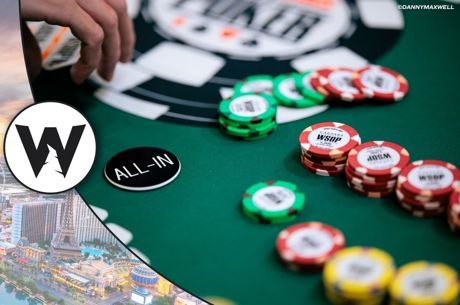Five Tips for Playing Single Table Satellites at the World Series of Poker

It’s almost here. The 2015 World Series of Poker begins tomorrow, with the first events kicking off mere hours from now. Thousands of poker players will be flocking to the Rio All-Suite Hotel and Casino with hopes of earning a WSOP bracelet, with the one awarded for winning the $10,000 buy-in Main Event the most coveted of them all.
Of course if you’re anything like me, you’re used to playing in tournaments where the entire prize pool is only $10,000 — or considerably less. If you’re short on cash but are dead set on giving it a shot anyway, the WSOP offers various satellite options that can get you in.
Single table satellites are probably the most misunderstood option of them all. I have some experience with the single table format, having successfully played the buy-ins from $125 to $225 which all have 1,000 starting stacks and 15-minute levels. Here are five tips that brought me success in these games.
Tip #1: Think twice about small suited connectors
Many of us like to play suited connectors because they can hit a ton of flops hard and win big pots. However in order to win a big pot, you first need to start with big stacks. In these satellites, you only start with 40 big blinds. If someone opens for a raise, you oftentimes won’t be getting the right price to play small-to-medium suited connectors because the implied odds are not good enough in shallow-stacked games.
You have to restrict yourself to playing the bigger suited connectors which are more likely to make top pair as well as good drawing hands. Against some people in these games, top pair with a decent kicker is like the nuts. Watch the hands you’re not in to spot the players who will stack off light.
Tip #2: Be cautious when set mining
Like suited connectors, many players love to call with small pairs because they too can hit flops hard and win big pots. This “set mining” strategy is a bit more feasible than playing suited connectors in single table satellites because when you do hit the flop, you have one of the best made hands possible. Also when you don’t hit the flop, it is usually fairly easy to get away from the hand without wasting more chips. A good rule of thumb is to call with these pairs if you expect a 10x (or better) return on your call, but this is where you have to be cautious.
First, the original raiser not only has to have enough chips behind to pay you off, but he also has to have a hand strong enough to do so. Again, watch the hands you’re not in. If you’ve seen your opponent playing tight, then he may be a good target for set mining. But if he has been splashing around with weak hands, you can’t expect him to hit the flop hard enough to give you his stack when you hit your set.
Second, you need to assess the likelihood of even seeing the flop if you make the call. If your target opens from early position and you call from a couple of seats over to set mine, an aggressive player behind you may take this as an opportunity to squeeze you out of the pot. If you’ve been observant you’ll have a better idea of the tendencies of the players behind you and thus can better anticipate if this might happen. You can’t hit the flop if you aren’t allowed to see it.
Tip #3: Win the pot
If you aren’t playing small suited connectors and sometimes not even small pairs, then what are you playing? Good Broadway hands and medium-to-big pairs. This is a very strong range of hands. When you are only putting in chips with these hands, you are often justified in fighting to the death. If I can increase my stack by around 20% with one of these hands, I am usually willing to risk it all to take the pot down by shoving. This play punishes players who are limping in or raising with small suited connectors and pairs. I’m that guy who won’t let them see the flop.
Occasionally, I will get a premium hand like AxAx or KxKx and the pot may not represent 20% of my stack. In this case, I am willing to milk it a little by raising less than all in. With these hands, I don’t mind letting one or two players see a flop, but if the board contains any draws, I am shoving my overpair to charge them the maximum.
When I am not the original raiser, I love just calling the raise with these hands against loose players who will raise light and automatically continuation bet any flop. But if the original raiser is tight, I’ll go ahead and shove to avoid the player seeing a bad flop that allows him to fold a hand like AxKx or JxJx. Again, observe the hands in which you’re not involved to identify which type of player the raiser is.
Tip #4: Play for the chop
Once you’ve made it through two or three levels, even the inexperienced players will recognize that these single table satellites tend to become shove fests (as if you hadn’t been playing it that way all along). Fortunately for you, many of them will not have survived to this point and the ones who did will likely have no idea of the ICM factors at work. Once these tournaments get down to three or four players, you should start to discuss chopping the prize pool.
As a bigger stack, you can insist on a “chip chop” knowing that your superior chip position and push-fold skills make for a great backup plan if no agreement is reached. If you are a short stack, you should try for the ol’ “these blinds are so big, anybody can be the next one out” routine and try to chop it evenly.
If you feel like the table is too tight and truly clueless about push-fold play, you may want to play it out to realize your massive edge by shoving more than your fair share of hands. But if the table is competent or too loose, then you should be more likely to take a deal. Once more, if you’ve been observant throughout you should be able to identify what type of players you’re dealing with when the chop discussion arises.
Tip #5: Watch the hands you’re not in
I’ve said it several times already, so I’m going to end by promoting this piece advice to the level of a “tip” to carry with you to your single table satellite. Once you fold a hand — and you will be folding a lot of them — don’t check out mentally, too. Pay attention!
Of course, that might be easier said than done. For competent players, single table satellites can seem like a mindless boring endeavor. There will be times when you simply are down to just shoving when you have a good hand and folding when you don’t. This uncomplicated “either/or” situation can cause even the most well intentioned of us to get Twitteritis and stop paying attention.
You’re not going to be in many hands, but watch the hands you’re not in. Poker is a game of information. It is amazing how much of it we can obtain without having to invest a single chip.
Want to stay atop all the latest in the poker world? If so, make sure to get PokerNews updates on your social media outlets. Follow us on Twitter and find us on both Facebook and Google+!








